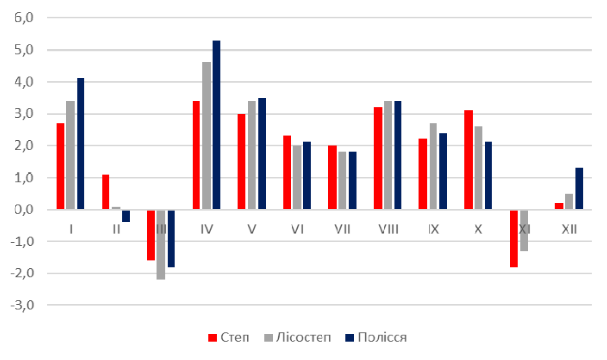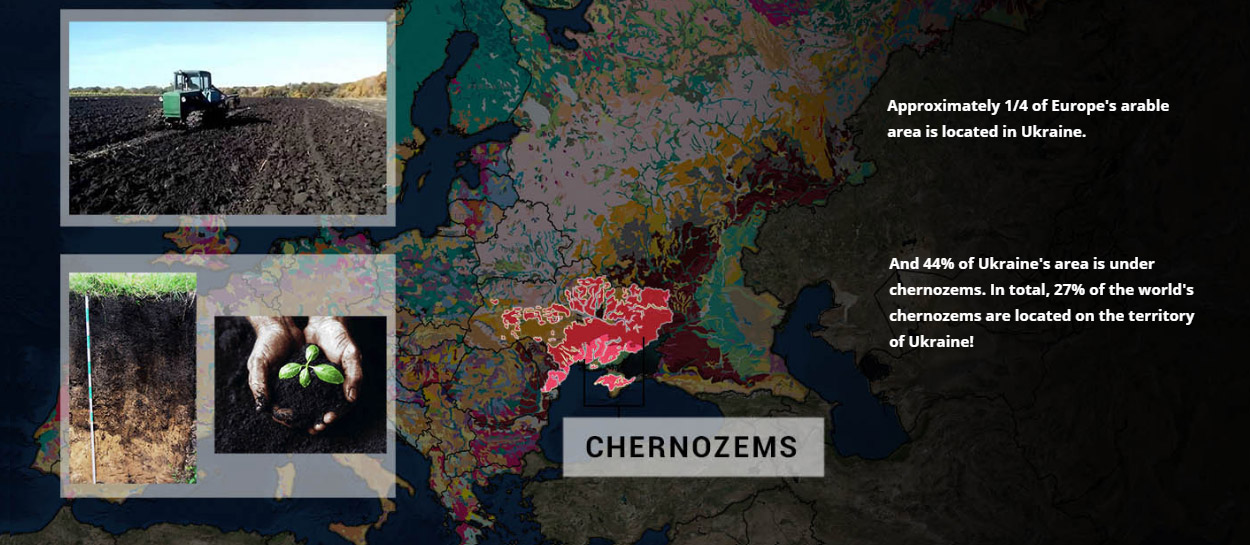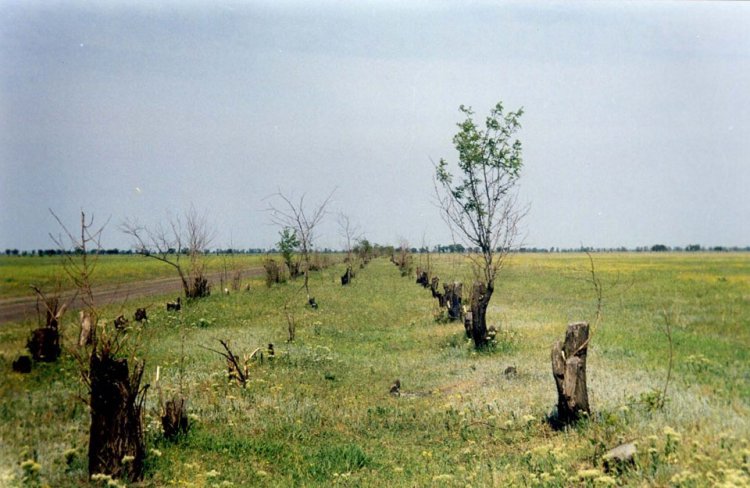#COVID19, fires near Chornobyl, now a sandstorm - what's next, locusts, ask Kyiv residents who are being asked to keep their windows closed by officials.
Climate change is cited as reason of storm - an abnormally dry winter has led to dry topsoil
Photo via @Biz_Ukraine_Mag pic.twitter.com/RfpRlIqFtX
— Euromaidan Press (@EuromaidanPress) April 16, 2020
Forest fires burning around Chornobyl and other Ukrainian northern regions for several weeks in April became media stars. These fires were started by humans and, more likely than not, by several groups of saboteurs. Yet one-off fires, despite their evident horror, are not as dangerous to nature as long-term effects on ecosystems due to excessive exploitation of natural resources -- in particular by intensive farming.
Dust storms, dried-up rivers, and desertification have hit Ukraine this spring thanks to the country suffering record low levels of precipitation. For the first time in 100 years, rivers are not fully filled up by melting snow and the usual abundant spring rainfall. Instead, fields with freshly planted grain were inundated by sand after dust storms in the country's north.
What has happened? Global climate change is one reason. The second no less important reason is intensive farming leaving an inadequate amount of uncultivated land.
in the world. Cultivated land is subjected to erosion, while artificial drainage of swamps and peatlands has damaged natural drainage basins, resulting in the loss of groundwater and rivers drying out.
Altogether, Ukraine, historically known as the Breadbasket of Europe, should be prepared for ecological disasters being the new norm unless sufficient measures are taken. But this story is also a warning to the world since in many countries human exploitation of nature is no less harmful.
The context of global climate change
A few figures from official reports reveal the true scope of the threat from climate change in Ukraine. During the last century, the average temperature in Ukraine has risen by more than two degrees celsius. However, of even more significance are seasonal changes, with spring and summer seasons in particular becoming hotter and drier. This renders traditional agricultural practices in Ukraine more difficult. Irrigation is needed but, most importantly, climate change leads to natural disasters and the death of entire ecosystems.

Precipitation is becoming irregular, with monthly rainfall totals falling in a few hours in one day with strong winds and storms. The rest of the month, especially in summer, remains dry. This means that while the amount of precipitation remains the same, the climate in Ukraine is becoming drier, the official data of the government reports.
The following diagram demonstrates how imbalanced precipitation spread was in 2018 as an example. During some months, amounts barely reached 40% of the monthly norm, while in other months it exceeded the average by up to 250%. Only four months in the year received close to the normal amount of precipitation.

Melioration (drainage) of waterlogged soils in order to have “more arable land” has led to the destruction of natural drainage basins, loss of groundwater and smaller inflow of rivers
The policy of amelioration was introduced during Soviet times to drain swamps and make them suitable for agriculture. Despite obvious natural disasters — loss of entire rivers and lakes throughout Ukraine — the policy was continued after the collapse of the USSR: no longer by the state but by owners of farmland and large agricultural companies that lease most Ukrainian land.
Two pictures below show the consequences of this policy. In 2003, the river Seym, in the Ukrainian north, used to be full of water. In the spring, the river flooded kilometers of land along its course. Local villagers had to put their hay on hills to avoid it being soaked (bails of hay are shown by arrows). These floods were important to saturate the land and raise the groundwater level. Also, several species of fish can only spawn in such situations.

A new typical situation is that water is drained by artificial channels and reeds that save rivers from clay are burned away to make the land and river easily accessible for humans. An example of the result is shown in the picture of the same Seym river in 2020.

Сultivated lands reduce natural capacity to recycle carbon and raise natural carbon emissions; dehydration leads to burning peatlands
Not only valuable natural ecosystems disappear after artificial drainage and melioration. Such a policy has many side effects. One of these is constantly burning peatlands. After groundwater levels fall, peat bogs dry out. Peat is a natural storehouse for carbon from decayed flora. Once dried out, peatlands start decomposing or burning, causing smog and additional carbon emissions.

The same logic applies to agricultural land, especially the chernozems, a type of fertile black soil that covers the Ukrainian steppes. This soil is a natural carbon sink, which is stored in the soil if it is covered by grass. But if plowed, the black soil starts decomposing and leads to additional carbon emissions.
Disproportionately large share of arable lands creates threat of dehydration and easier erosion

Is the amount of arable land dangerous per se? We put this question to Tetyana Kuchma, senior research fellow in the Institute of agro-ecology and nature management in the National Academy of Science of Ukraine. She answered yes.
In the 1920s, Ukrainian steppes had already encountered major soil erosion and dust storms due to intensive farming. As a result, windbreaks were planted between fields throughout the country to stop winds and save the land from erosion. Today, these windbreaks have either been abandoned, cut down, or have just naturally degraded. As a result, dust storms face fewer obstacles.

Ukraine has the highest share of cultivated land in the world. In some districts, 90% of the territory is plowed, Kuchma explains. The normal maximum share of cultivated lands is estimated at around 40%. However, the figure can be even lower, depending as it does on the technology of cultivation that is used. For example, plowing is typical for Ukraine but it is also the worst method from the ecological perspective. Also, monocultures sown on hundreds of hectares by huge companies for the sake of profit, without following the principles of crop rotation, is further worsening the situation.
Farmers themselves are already facing, and will face yet more economic losses if they use land improperly, Tetyana Kuchma explains. However, immediate changes seem impossible. The state services do not properly monitor compliance with official farming norms. On the other hand, soil is suffering degradation throughout the world: European agricultural institutions, for example, are constantly looking for more agricultural land abroad. Realistically, it is almost impossible to expect that people will abandon their land to let grass and forests grow on it.
What can be done initially is to save swamps and river beds, and plan on the level of local drainage basins, Tetyana Kuchma thinks. With such a policy, considerable results may be achieved with minimal interventions.
Artificial pine forests drier and more combustible than natural mixed forests
Not only large-scale farming but even artificial forestry is dangerous. In Ukraine’s Polissia (natural forest zone) few natural mixed forests remain. Instead, pine forests were artificially planted during Soviet times. Today, foresters continue to plant pine on land where natural forests have been cleared. Pine trees grow more quickly and are useful for industry, yet without natural grass and bushes that trap water, the pine trees make soil drier. During periods of irregular precipitation, pine forests remain constantly dry, with even a small fire being able to cause a major disaster. One of the reasons why it has been so hard to extinguish the 2020 Chornobyl fires is that pine forests were planted there. Instead, forests should be allowed to renew naturally with many species of trees, the Ukrainian Nature Conservation Group writes.
Desertification as the final result
By definition, desertification is the absence of permanent vegetation cover or its sparseness, the loss of a fertile soil layer, and not a change of climate zones, as some people may think, ecologist Oleksiy Vasyliuk writes.
Intensive farming has already led to a situation where not only land with natural vegetation is scarce. Even a single harvest is becoming a problem in some districts, while dust and sand, carried by dry winds, are covering huge areas of land.
The spring of 2020 shows that Ukraine is heading on a path towards desertification. The winter of 2020 passed almost entirely without snow, with the spring similarly almost entirely without normal rainfall. As a result, Ukraine’s rivers now have their lowest water levels in 100 years. The water flow of Ukraine’s largest river, the Dnipro, is already 23% below the norm for April. Many small rivers have even less water in comparison to the norm. If May should be as lacking in rainfall as March and April, the overall surface runoff in Ukraine may constitute only 1/3 of the normal spring runoff.
In total, Ukraine consumes only 1/4 of its domestic agricultural products. 3/4 are sold for export. Therefore, the government and farmers have to choose between short-term profits in US$ and long-term ecological stability that is needed to continue sustainable farming for decades and centuries.
Read also:
- On the verge of disaster: top 5 environmental problems in Ukraine
- Ukraine’s largest steel producer & foreign investor accuses SBU of raid, Zelenskyy – of “eco-populism”
- Punishment or well-designed institutions: what will eliminate corruption in Ukraine?
- Chornobyl wildfires that raged for ten days near nuclear facilities extinguished, no radiation threat reported
- Meet the Ukrainians who returned to live in Chornobyl
- Nature takes over Ukraine’s Chornobyl exclusion zone
- What caused the environmental disaster in occupied Crimea? A chemist explains
- Russia can’t solve Crimea’s water problem
- Size matters: why Dutch businessmen like Ukraine
- Moratorium on land sales no more: how Ukraine’s land market will operate with the new law

